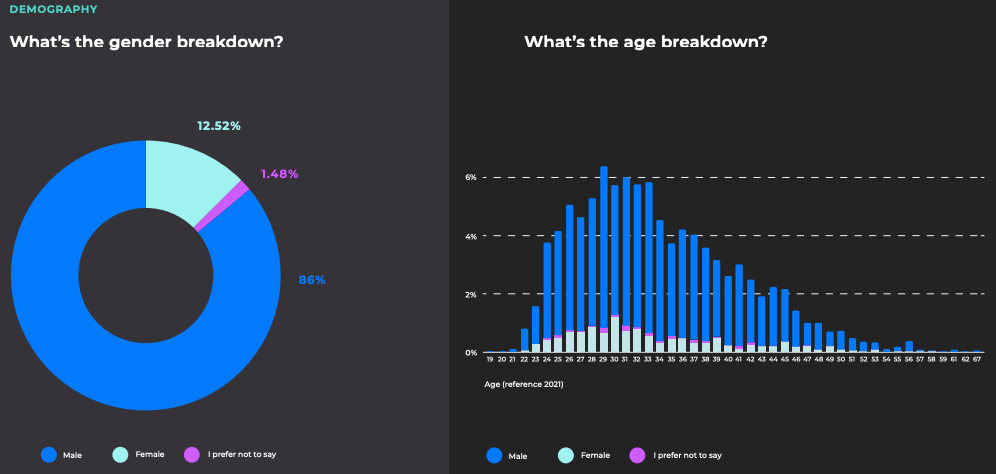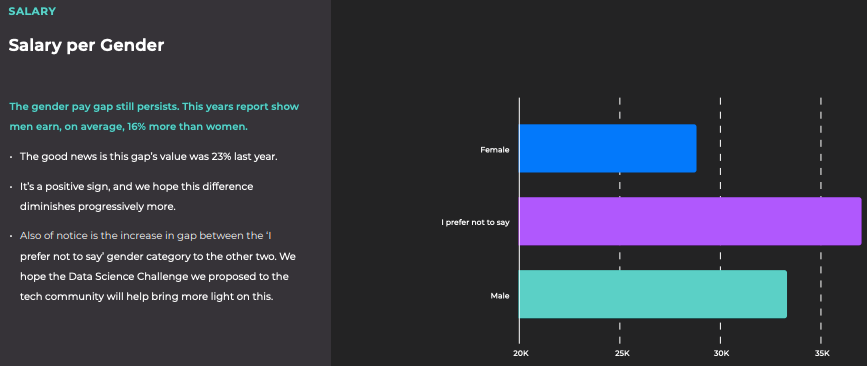The short answer is: yes, we do.
The tech industry has a long way to go when it comes to attracting more women to STEM — science, technology, engineering and maths — careers. Not only that, it needs to do a better job at helping them thrive once they enter the industry.
We have the statistics. Our study–the Tech Careers Report–shows that only about 13% of tech professionals are women. Accenture’s study also shows us that 50% of women abandon their tech careers by the age of 35 and that they’re leaving tech roles at a 45% higher rate than men.

What’s preventing us from being an IT industry that is representative and diverse?
- Women have a long history of being the main caretakers. A survey showed that during the pandemic, 29% of women “had taken on a greater childcare burden compared to 19% of men”.
- Chicken-or-egg problem called “affinity bias”. Despite the efforts to recruit more diverse talent, including more women, there is still what’s called an “affinity bias”: when people naturally tend to hire candidates who are more like them. What happens when most executive and senior positions in tech are held by men? And the cycle repeats itself — when fewer women apply, fewer are hired, which leads to fewer women in hiring positions in the company, and on it goes.
- There is less support for women in tech. Have you ever relied on a mentor at work? For so many, it’s a critical factor in their workplace to navigate career development. However, the odds are against you if you’re a woman. Given the small number of women in tech — especially in management and executive roles — women working their way up the ladder have fewer people like them to aspire to.
- An ingrained “bro culture”. Books have been written about this aspect of Silicon Valley, but it extends far beyond that niche and that geography. The tech industry is still being talked about as a space of men, largely populated by men. As long as women still feel the effects of the pervasive “bro culture” at work, they will never feel like tech is a space for them.
When the people making the decisions and building the products are mostly men, it isn’t just women working in the industry who lose out — it’s women at large.–Technopedia
What can be done?
There are things that can be done in all of the funnels.
Educating.
Everything starts at home and in schools. A rooted problem like the gender gap can’t be fixed by companies alone, although they can push solutions immensely. The most simple things can and should be learned far before you enter the job market.
Hiring.
Being more conscious in this process can surely help avoid “affinity bias”. We need to be more mindful of our actions and their repercussions, not only within our company, but on a global scale as well. Considering a diverse hiring panel and rewriting job descriptions that remove irrelevant information can be a great starting point.
Retaining.
Role models, sponsors, mentors, and peer support can make a big difference in retaining talent. Even if the numbers aren’t in women’s favour, it’s important that they form a strong network. Although women will tend to lean on each other for support–and rightly so–male allies are just as important.
Creating flexible ways of work is also forefront in times like this. If women are leaving because of childcare or caregiver responsibilities, let’s create an environment where they can adjust their work schedule and keep pursuing their career goals.
Equalling women’s salaries to men’s should also be on the table. Our studies show us that men earn, on average, 16% more than women.

Welcoming.
A lot of women who are faced with the hard decision of abandoning their career–whether related to childcare, toxic working environments, the pandemic–do it in the hopes that it’s temporary. It’s crucial for these women who are afraid of returning and don’t know where to start their re-entry, to have specific programs in place that support them on their journey back, that helps them refresh their skills and situates them on the market.
While supporting parents and caregivers has a cost, several studies also suggest improvements in employee retention may outweigh the cost of paid leave.–Technopedia
The tech industry needs talents of all kinds and we must double down on our efforts to inspire women in ways that make them want to come work in tech and lead fulfilling and challenging careers.
Change will not come fast. Deep-rooted issues need time to improve, but can only happen with continued effort and awareness. As long as we keep rowing in the same direction, slowly but surely we can make the tech industry a more inclusive and diverse place.
If you enjoyed this blog post, here are other reads you might like: How women in tech can pick up the industry’s pace |5 tips to create a more diverse and inclusive workplace! (PWIT)
PS: looking for a job in tech? Browse 600+ here and start applying!






0 Comments